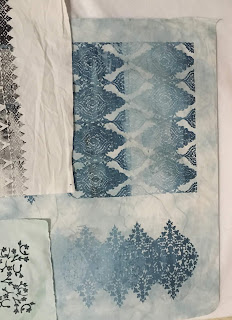Do you like to run experiments when you discover a product you've never used? I think I originally became a scientist because I love to do experiments. Now that I'm an artist, I find this skill handy and still fun. The product I'm writing about is called
Fiber Etch. I found out about it from Jane Dunnewold when I took the Art Cloth Mastery Class and decided it had potential in my artwork so I ordered a bottle of it. Basically, it destroys cellulose-based materials, which means you can use it to selectively dissolve cotton fabric. My friend,
Angie Knowles, sent me a sample of a silk-cotton fabric she had purchased so that I could try Fiber Etch on it.
Here's what I did and the results:
1.) I applied the Fiber Etch (which is a thick liquid a little thicker than maple syrup) through a thermofax screen onto the fabric.
 |
| the fabric wet with fiber etch |
 |
| the thermofax design I used |
2.) I let it dry overnight.
3.) I ironed it to heat-destroy the cotton fibers where the Fiber Etch had made contact.
 |
| the brown parts are where the cotton got destroyed |
4.) I soaked it in warm water for about 10 minutes and softly rubbed it with my hands.
5.) I hung it to dry
6.) I ironed it flat and brushed it with a scrub brush (but gently) to remove any stray cotton fibers.
 |
| this design was not a good choice since it didn't keep the detail... too much cotton got destroyed. |
 |
| I redid it with 3 other thermofax screens to try for a more suitable design for using with this product |
You can see from the results that this particular fabric is made using silk woven in one direction and cotton in the other, so the result from the fiber etched parts is silk fibers running in one direction with no fibers woven with them in the areas that got etched. This works ok for designs with thin lines or thin shapes, but leaves an area too open for designs with bigger shapes.
7.) I put it in a dye bath of procion MX dyes ( sun yellow mixed with mixing blue 50:50). (I chose this color mixture because I was aware that cotton turns a different green hue in it than silk does).
8.) Batched it for 24 hours, rinsed it, dried it, and ironed it.
 |
| the silk fibers dye a more yellow green and the cotton fibers dye a more blue-green. |
You can see the silk fibers running vertically in the etched areas.
I had previously tried this product with a poly-cotton fabric in which the all the threads are a mix of cotton and poly. The result is more effective with this type of fabric because you end up with woven shapes in the etched areas, but they are thinner since all the cotton gets removed and only polyester remains.
 |
The remaining polyester threads (in the etched areas) don't accept the dye; only the cotton does.
So you end up with your thermofax-etched areas staying white |
The whole cloth dyes lighter than expected since the polyester part doesn't accept the dye.
I have more things I want to try with this product, but this is a good start and I found it interesting to see how the thread structure plays a roll in the results. I'm linking this to
Off The Wall Friday where you can find other art blogs. Please make comments on the artists' post to let them know you stopped by. Thanks for visiting.





































